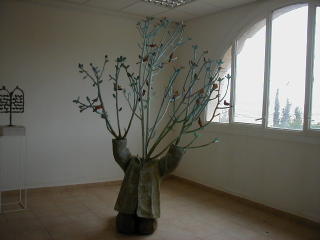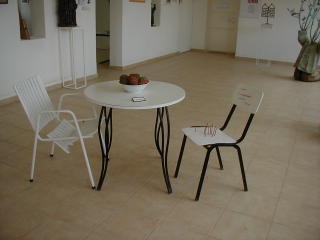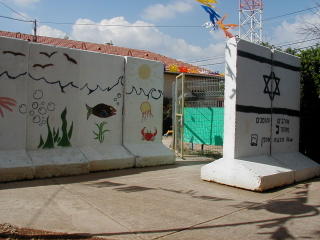Monday May 30, 2005
TRIP TO SHOMRON
I decided to go on a fact-finding trip to the four communities in the Shomron that are slated for destruction under Sharon’s Disengagement Plan. I have always traveled to Gush Katif for rallies, demonstrations etc, but never to the Shomron. I decided it was time to visit these settlements so that I would be aware of facts on the ground so that I could speak intelligently about the situation.
This trip was organized by the David Bedin of the Israel Resource News Agency. Most of the people in the group were reporters: locals as well as foreign press. I am not a journalist, but an observer, a concerned citizen who is against the Disengagement. I was born in America and have been living in Israel thirty-five years.
These four communities are: Sa-nur, Homesh, Ganim and Kadim.
The first community we visited was Sa-nur. You must understand that the approach road to this community is straddled by Arab villages on both sides of the road. There is a major army checkpoint before one reaches the actual settlement. The road is narrow and not in the best condition. Sa-nur was settled in the 1980s by Russian artists. During 2000-2004 the inhabitants suffered terribly during the war. The road was constantly under fire and anyone traveling to or from the settlement was a target of terrorist fire. Most of the inhabitants left the community. Only one couple remained.
It was obvious that if this community was completely abandoned then the terrorists would move in and take over, thereby acquiring one of the most strategic sites in the entire area. Young religious and secular families decided to move in and hold the lines. Now there are thirty families – about 170 people living in the community. They are building a new Beit Knesset (Synagogue) to be named for Raful (Raphael Eitan).
We met with the community’s spokesperson: Miriam Adler. She is a young woman (29 years of age) -- the mother of seven children. She made aliyah in 1988 with her parents from the FSU. Her parents were refuseniks. She explained that since the community has been repopulated that several artists have returned – some just to work, others to take up residence again as well.
The journalists asked numerous questions:
1. What do you expect to happen in August? The army/police will try to force us out of our homes.
2. What will be your response? We will resist.
3. Will there be violence? We will not initiate violence but will return it. We will defend ourselves.
4. What do you think the government will do? The soldiers/police will try to take the children away from the parents because then they believe the parents will go and run after their children.
5. Why do you think the forces will pull the children from your arms? I know this personally because it has happened before. The Disengagement Authority wanted to send representatives here to speak with us. We told them not to come because we had nothing to say to them. They informed us that they were coming anyway. We, the women lined up across the entrance to our community. Many of us have infants so we were holding them. The police/soldiers were ordered to grab the children. Two members of the forces approached me. One grabbed me and held me while the other took my baby from my arms. This happened to me. I know they are capable of doing this because they have done it already. We have no intention of letting it happen again.
6. Why do you think Sharon is doing this? Because he has decided to be the head of the mafia instead of the head of state. He is busy protecting his sons so they don’t go to prison. He has made a deal with the left to protect his sons.
7. How will you win? Thousands of people who support us, who think the Disengagement is wrong will come to support us. The army and police cannot cope with so many people.
Before our visit ended we strolled through the art gallery. The artists who settled in this community are not amateurs but ones who have won world renown. The work on display is exquisite. There are works of great beauty such as the Tree of Life metalwork/sculpture. Juxtaposed to such art are the surrealistic pieces that reflect on reality: the war on terror. One sees a table with two chairs – typical of what you would sit on in an outdoor café. Except here the bowl in the center of the table has hand grenades in it instead of fruit. One chair has nails sticking up from the seat.

Our next stop was Homesh. Menucha Hazani is the spokesperson for the community and she gave us a history of the yishuv.This settlement was founded twenty-four years ago. Originally it was a secular yishuv with no religious inhabitants. The community suffered greatly during 2000-2004. Three people were killed on the road and many others injured. When the inhabitants left for work in the morning to go to work in the larger cities, such as Tel Aviv, Netanya, etc. they did not know if they would arrive at work or return home alive. Many left during these years of terror.
Again there was small core that stayed rather than surrender the area to the terrorists. The remaining group decided to invited people to join the community and decided to open membership to everyone religious as well as secular. Three religious families decided to settle here – young families with young children. It was very difficult for them. They did not have a Beit Knesset, they did not have a minyan and there was no mikveh. After two years another religious family arrived. Soon after the husband was murdered on the road and his wife seriously injured. The three families were seriously considering leaving Homesh.
However, the call went out for support and the call was answered. Other families came to live in the community. At the same time a yeshivah was opened with thirty students. Now Homesh has 55 families of which 18 are religious. There are three hundred permanent residents plus a student body of 30 at the yeshivah. It is a vibrant community.
Not all of the residents leave the community for work outside. There are three factories in the yishuv: one connected with cars; a bakery and a metal factory.
The journalists asked her why she thinks the community should not be dismantled. She gave three reasons:
1. This is part of Eretz Yisrael. We, the Jews, have the right to be everywhere in this land. It is ours and it was given to us by God.
2. Strategic reasons: Homesh is a hilltop community. It is 600 meters above sea level. It is the highest mountain in the area and commands a view of all the surrounding terrain. It is 35 kilometers from Tel Aviv and Netanya is 15 miles away. One can see the ships on the Mediterranean Sea on a clear day. If terrorists ever gain control of this area they will be able to fire rockets, missiles, whatever they want on any city or town in the coastal plain. It would be suicide to ever relinquish control over this area.
Other questions asked by the journalists:
1. Are you preparing for the Disengagement? I am going about my daily routine: work, taking care of my children. The community is stockpiling supplies of food and water so we can stay here for an extended time without having to leave the settlement.
2. What is your view on civil disobedience? Will you resist? Yes, we are not leaving our homes. Most people in the community are remaining. A few have decided to leave and take compensation. That is their decision, but the majority refuses to leave their homes.
3. How will you resist? Nonviolently. We will not initiate violence. We are hoping that tens of thousands or hundreds of thousands of supporters will come here as they did on Chol Hamoed Pesach. So many people will block the roads. The police and the army will not be able to cope with so many people. We will not let busloads of police or soldiers pass on the road or enter the yishuv.
4. How do you justify civil disobedience? There are security and ideological reasons not to give up the land.
5. Isn’t the government doing everything possible to ease your plight? Compensation etc.? No government representative has come here. We have not been told anything. One person from the community signed an agreement with the government. No more.
6. Did you pressure people not to cooperate? No, not at all. Each family has made its own decision. The majority has decided to stay.
7. Isn’t there an obligation to the government? Doesn’t every citizen have to obey the law? Disengagement is an immoral and unethical act by the government!! The MKs (members of Knesset) cannot steal the mandate from the people.
8. But the Prime Minister has the backing of the Knesset and most of the population? The polls demonstrate this. You can’t run a country on polls. There has been no public discourse. The Supreme Court and the press support the government. The courts and the press (media) are left wing. Since Sharon is implementing a left-wing policy they support him 100%. It is a dictatorship. If the government is so sure that the majority of the public supports its Disengagement Plan then prove by having a referendum.
9. Do you think where you could go, that is relocate? No I don’t consider it.
10. Have you or any members of the community gone for psychological counseling? No.
11. How do you relate to disengagement? Disengagement is like being raped. If you think you are threatened you protect yourself at all costs.
12. What is the children’s response? They are afraid of Sharon. They feel betrayed.
13. Where do you see your children growing up? Here, in our community. I was in Yamit with my family when I was five years old. I don’t want my children to lose their home the way I lost mine. Sharon must come back to the people!
After Homesh we traveled to Ganim. It is only about 20-30 minutes away from Homesh, but the area on the direct route has been put under the authority of the PA so we had to detour and travel a convoluted route that took 1.5 hours.
When we arrived in Ganim we spoke with an English-speaking inhabit by the name of Aaron Yarden. First he told us something about the community. It was established twenty-two years ago. It is a secular settlement. There are about 35 families – 105 people. It is near Western Jenin.
Aaron came to Israel 15 years ago, liked the country and stayed. He lived in the Golan Heights on a kibbutz for 8 years and then moved with his wife to Ganim.
The last four years life has been very difficult for the yishuv. One woman was killed by terrorists, one woman was stabbed and one soldier was stabbed. The residents have faced danger both within the settlement and on the roads. Remember most of the inhabitants leave the community to work.
Some people were traumatized and left. The yishuv is very isolated. It is the northernmost settlement in the Shomron area. The Regional Council pays less attention to the secular settlements according to Aaron. They don’t get all the services they are entitled to receiving. Prior to 2000 the Ganim residents had good relationships with the Palestinians in Jenin. They used to visit one another. Now the people in Ganim are the target of terrorists.
The journalists asked him if the residents of Ganim were going to resist using civil disobedience. He said 90% of the settlers in Ganim were “law-abiding” citizens so they will leave quietly. He thinks anyone who resists the government is a criminal. He believes that anyone who would attack a soldier or a policeman is a criminal.
Despite these views, he is no fan of the Disengagement Authority. According to Aaron this bureau whose duty it is to help resettle people affected by the disengagement is worthless. There has been almost a total lack of communication. When anyone in the community has questions for this Disengagement Authority no one has answers. They have no information and no authority. It’s purpose appears to be to make life more difficult for the settlers.
Aaron and his family are going to the Golan Heights. He hired a lawyer to deal with the Disengagement Authority and apparently has gotten some money. He and his wife will be building a home in Katzrin. Aaron says the authority only compensates for property. There is no compensation for one’s life – what one has invested in the community. No compensation for uprooting one’s children and separating them from their friends.
The people in Ganim are sad. They are not being relocated as a group. A few families who are very close may move together to a new location, but the majority of the residents are moving as single families.
I want to mention that we sat under a tree near the nursery school while Aaron spoke to us. There was an anti-sniper wall constructed from upright concrete blocks that ran the entire length of the fence surrounding the nursery school. The opening was where the gate stood so that the children could enter and leave. Someone had painted colorful pictures on the blocks: animals, clowns etc., but drawings could not disguise the fact that the children had to be protected from terrorist fire.
We drove threw the fourth community of Kadim. It is a sister community of Ganim, also secular. They also plan to leave quietly. They have also complained about being ignored by the Disengagement Authority.
I was particularly interested in the different responses to the Disengagement Plan. The first two communities, Sa-nur and Homesh demonstrated defiance and a willingness to resist. They have strong ties to the land and will not cooperate with the government. They are counting on strong support from the general population to help prevent surrendering this strategic area to the enemy. However, in Ganim and Kadim those we spoke to said the law is the law and they are willing to go quietly into the night – to be resettled somewhere else. When they leave the terrorists will move in and open fire on the coastal plain.
Life today in Jerusalem

0 Comments:
Post a Comment
<< Home